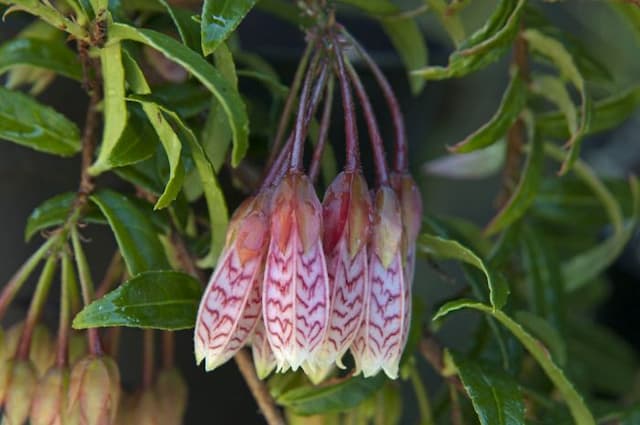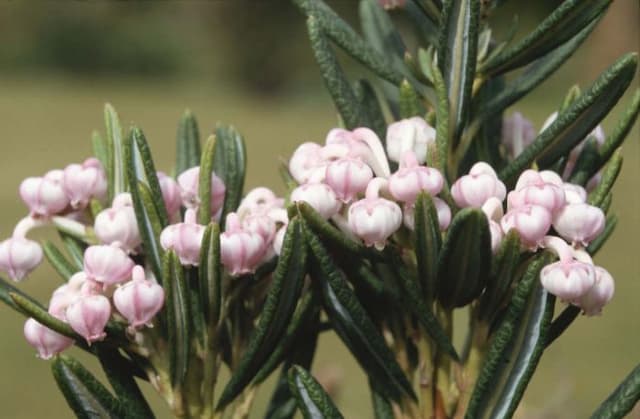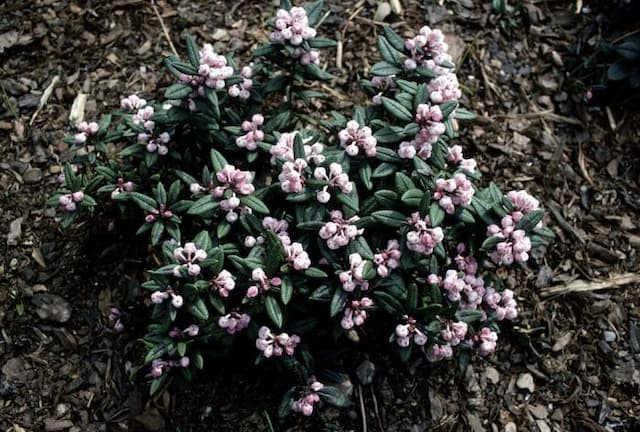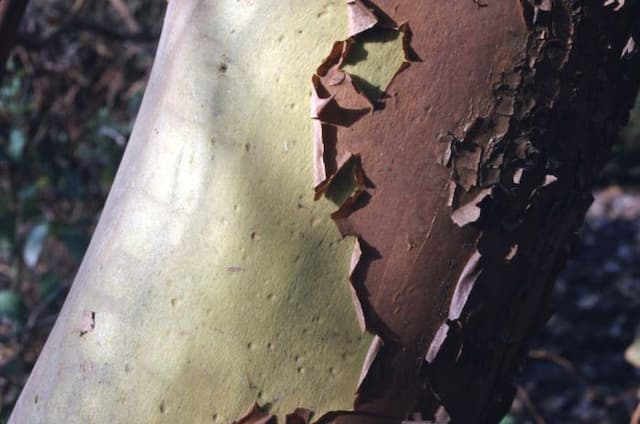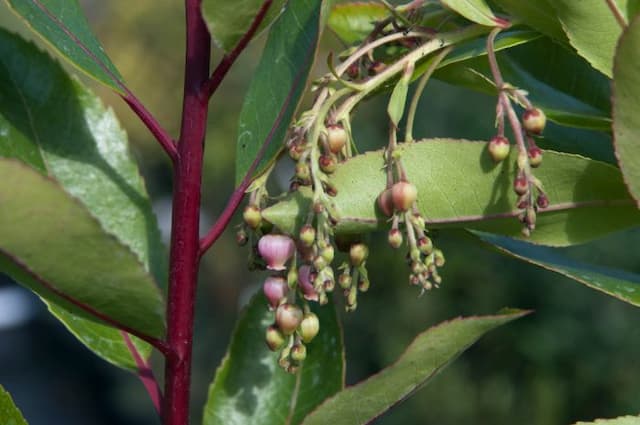Rhododendron Rhododendron (Loderi Group) 'Loderi Pink Topaz'

ABOUT
The Rhododendron 'Loderi Pink Topaz,' part of the Loderi Group, showcases a stunning display of blossoms that capture the essence of spring. This evergreen shrub is adorned with large, leathery leaves that provide a lush green backdrop throughout the year. During the blooming period, it becomes a focal point of visual interest thanks to its magnificent flowers. The flowers of 'Loderi Pink Topaz' are notable for their soft pink coloring that imparts a gentle yet vibrant tone to any garden. These blooms are funnel-shaped, with a delicate, waxy texture that feels luxurious to the touch. Each flower cluster brings together multiple individual blossoms, creating a dense, rounded truss that looks opulent and is sure to draw attention. Adding to the allure of this Rhododendron are the pronounced stamens and pistil that extend from the center of each flower, typically contrasting with the petals in color and emphasizing the flower's structure. The stamens are elegantly surrounded by dotted brown speckles that freckle the interior of the bloom, drawing the eye and adding depth to the overall appearance. When not in bloom, the 'Loderi Pink Topaz' retains its attractiveness through the glossy, dark green leaves that may have a slightly curved edge. The foliage is arranged symmetrically around the branches, giving this shrub a neat and orderly appearance, further adding to its year-round appeal.
About this plant
 Names
NamesSynonyms
Loderi Pink Topaz Rhododendron, Pink Topaz Rhododendron
Common names
Rhododendron 'Loderi Pink Topaz'
 Toxicity
ToxicityTo humans
Rhododendron, including the 'Loderi Pink Topaz', contains toxic compounds called grayanotoxins. If ingested by humans, these toxins can cause symptoms such as vomiting, diarrhea, drooling, weakness, and confusion. Severe poisonings can lead to a drop in blood pressure, coma, and even death. It is important to avoid consuming any part of a rhododendron plant.
To pets
Rhododendron is toxic to pets as well. Ingesting even a few leaves can cause symptoms of poisoning in animals. Symptom manifestations may include vomiting, diarrhea, drooling, weakness, difficulty walking, and in severe cases, seizures, coma, and death. All parts of the plant are poisonous, and it is crucial to prevent pets from ingesting any part of a rhododendron.
 Characteristics
CharacteristicsLife cycle
Perennials
Foliage type
Evergreen
Color of leaves
Green
Flower color
Pink
Height
8 feet (2.4 meters)
Spread
8 feet (2.4 meters)
Plant type
Shrub
Hardiness zones
7
Native area
Asia
Benefits
 General Benefits
General Benefits- Aesthetic Appeal: Rhododendrons provide a striking display of large, fragrant, pink flowers that enhance the beauty of any garden.
- Landscape Diversity: Their unique floral characteristics can add variety to a landscape's visual design.
- Shade Tolerance: Rhododendrons can thrive in partially shaded areas where other flowering plants may struggle.
- Seasonal Interest: They bloom in late spring, offering seasonal interest after many early-spring flowers have faded.
- Attracts Wildlife: The blossoms of the rhododendron can attract pollinators such as bees and butterflies to the garden.
- Evergreen Foliage: Rhododendrons retain their leathery foliage year-round, providing greenery even in the winter months.
- Soil Erosion Control: The extensive root system can help stabilize soil and prevent erosion on slopes.
- Privacy and Screening: Their dense growth habit makes them excellent for creating private spaces or screening unsightly views.
- Low Maintenance: Once established, rhododendrons generally require minimal care aside from regular watering and occasional pruning.
- Variety of Sizes: They come in various sizes, from small shrubs to large trees, which can fit different garden sizes and styles.
 Medical Properties
Medical PropertiesThis plant is not used for medical purposes.
 Air-purifying Qualities
Air-purifying QualitiesThis plant is not specifically known for air purifying qualities.
 Other Uses
Other Uses- Art and Illustration: The Rhododendron's vibrant flowers are often used as subjects for botanical illustrations and garden-inspired artwork, capturing their beauty in various forms of media.
- Photography Backdrops: The lush blooms and foliage of Rhododendrons provide an attractive and natural backdrop for outdoor portrait photography.
- Horticultural Shows: Rhododendrons are a popular choice for display in garden and flower shows, where different cultivars are showcased for their unique colors and forms.
- Educational Tool: Botany students may use Rhododendrons to study plant biology and hybridization techniques due to the wide variety of species and hybrids.
- Landscaping Themes: These plants are utilized to create specific landscaping themes, such as Asian-inspired or woodland gardens, where their origins and aesthetics align with the design.
- Inspiration for Culinary Presentation: While not edible, the flowers inspire plating and presentation in culinary arts, using their color and form as a muse for dish aesthetics.
- Cultural Symbolism: In some cultures, Rhododendrons have symbolic meanings and are used in festivals or celebrations to convey different sentiments such as caution or bewilderment.
- Textile Design Inspiration: The patterns and colors of Rhododendron flowers inspire fabric and textile designs for fashion and home decor.
- Wedding Venue Decoration: The aesthetic appeal of Rhododendrons makes them ideal for decorating wedding venues, especially during their blooming season.
- Nature-Inspired Crafts: The shape and structure of the Rhododendron's flowers and leaves are replicated in crafts such as paper flower making or botanical jewelry.
Interesting Facts
 Feng Shui
Feng ShuiThe Rhododendron is not used in Feng Shui practice.
 Zodiac Sign Compitability
Zodiac Sign CompitabilityThe Rhododendron is not used in astrology practice.
 Plant Symbolism
Plant Symbolism- Beware: Rhododendrons, including the Loderi Pink Diamond, are often associated with caution due to the toxic nature of their leaves. Historically, they have been used to symbolize a warning or to be wary.
- Elegance and Wealth: With their lush, vibrant blooms, rhododendrons can symbolize sophistication and abundance, often associated with prosperity.
- Temporary Beauty: The brief but stunning flowering period of the rhododendron can represent the fleeting nature of beauty and how it must be appreciated in the moment.
- Survival: Rhododendrons are hardy plants able to thrive in challenging conditions, making them a symbol of endurance and the ability to overcome adversity.
 Water
WaterLoderi Pink Topaz rhododendrons require even moisture and should be watered deeply once a week, with the goal of giving the roots about one inch of water. During the hotter, drier months it may be necessary to water more frequently, such as every 3-4 days, to maintain moisture levels. It’s important to ensure that the plant has well-draining soil to prevent waterlogging, as standing water can lead to root rot. In terms of gallons, this usually translates to about 1-2 gallons per week for a medium-sized shrub, depending on the weather and soil conditions. Adjust the amount of water to less frequent intervals during the cooler or rainy seasons to match the plant's reduced need for water.
 Light
LightLoderi Pink Topaz rhododendrons thrive in partial shade to filtered sunlight. They should be positioned where they can receive morning light but are shielded from the harsh afternoon sun, which can scorch their leaves. An ideal spot is under the canopy of tall trees that provide dappled sunlight, replicating the understory environment of their natural habitat. Direct, hot sun should be avoided to keep the plant healthy.
 Temperature
TemperatureLoderi Pink Topaz rhododendrons do best in climates where temperatures typically range between 40°F and 75°F. They can tolerate minimum temperatures down to about 20°F, but severe cold can be damaging, especially to flower buds. Rhododendrons prefer to be in an environment that doesn’t experience extreme highs or lows, with an ideal growing temperature being a consistent range within the 60s to low 70s Fahrenheit.
 Pruning
PruningPruning Loderi Pink Topaz rhododendrons is typically done to maintain shape, remove dead or diseased branches, and encourage bushier growth. The best time to prune is after the plant has finished flowering, usually in early summer. Light pruning to remove spent flower clusters known as "deadheading" can be done to encourage more blooms the following year. Major pruning should be infrequent, focusing on shaping and removing any crossing or crowded branches to ensure good air circulation.
 Cleaning
CleaningAs needed
 Soil
SoilRhododendrons require an acidic soil with a pH range of 4.5 to 6.0 for optimal growth. A well-draining soil mix composed of equal parts peat moss, pine bark, and perlite is ideal to ensure proper aeration and moisture retention. Regularly test soil pH and amend with sulfur if it becomes too alkaline.
 Repotting
RepottingRhododendrons, like 'Loderi Pink Topaz', typically need repotting every 2 to 3 years or when they become root-bound. Spring is the best time to repot, just before new growth begins. Use a pot just slightly larger than the current one to avoid oversaturating the roots.
 Humidity & Misting
Humidity & MistingRhododendrons thrive best in environments with high humidity, ideally between 40-60%. If the air is too dry, especially indoors, consider using a humidifier or placing water trays near the plant to increase ambient moisture.
 Suitable locations
Suitable locationsIndoor
Keep in bright, indirect light with high humidity.
Outdoor
Plant in partial shade, shelter from strong winds.
Hardiness zone
7-9 USDA
 Life cycle
Life cycleRhododendron 'Loderi Pink Topaz,' a type of rhododendron, begins its life cycle with seed germination, which requires a well-drained, moist acidic soil with high humidity and cool temperatures. Following germination, the seedling phase sees slow growth as the plant develops a root system and foliage. As it enters the juvenile phase, the plant becomes more established with increased leaf production, and within several years, it matures to the point where it can produce buds. These buds will undergo vernalization over winter and then bloom into fragrant pink flowers in the spring, usually around May. After pollination, the flowers develop into seed pods, which then disperse seeds to start a new generation. Once mature, rhododendrons can have a long life span, ranging from several decades to over a century with proper care, continuing to flower annually.
 Propogation
PropogationPropogation time
Spring-Early Summer
Rhododendron 'Loderi Pink Topaz' is commonly propagated through semi-hardwood cuttings. The optimal time to take these cuttings is typically late summer, as this is when the current year's growth has started to mature but is not yet fully hardened. To propagate, select a healthy stem with several sets of leaves. Cut a 4 to 6 inch (approximately 10 to 15 cm) section of stem just below a set of leaves. Remove the leaves from the lower half of the cutting, and dip the cut end in rooting hormone powder to encourage root growth. Then, insert the cutting into a pot filled with a mix of peat and perlite or a sterile propagation medium. Place the pot in a warm, humid environment out of direct sunlight and keep the medium moist. Roots typically develop within several weeks to a few months.
